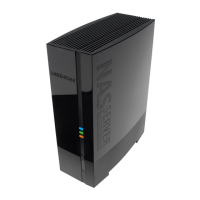
Do you have a question about the Medion LIFE P89626 MD 86407 and is the answer not in the manual?
| Model | Medion LIFE P89626 MD 86407 |
|---|---|
| Category | Network storage |
| Number of Hard Drives Supported | 1 |
| Hard Drive Interface | SATA |
| USB Ports | 1 x USB 2.0 |
| Type | Network Attached Storage |
| Network Interface | Ethernet |
| Connectivity | Ethernet |
| Interface | Ethernet |
| Protocols | SMB, FTP |
| Compatibility | Windows, Mac OS |
| Power Supply | External AC Adapter |
Guidance on reading and understanding the manual's instructions, symbols, and keywords.
Explains the meaning of danger, warning, caution, and note symbols used throughout the manual.
Defines the intended use of the NAS as a file server in dry, indoor, private environments.
General safety precautions, device handling, and guidelines for optimal setup location.
Warns against self-repair and covers cleaning, data backup, and power supply safety.
Specifies power requirements and advice on handling electrostatic charge for device operation.
Details supported formats, common applications, and the NAS server's hardware and software components.
Lists key hardware parts and illustrates device ports and indicators with numbered labels for identification.
Instructions for connecting the NAS to a network and USB devices, including the OTC function.
Guides on installing the NAS Starter Utility and optional Memeo Backup software for initial device configuration.
Describes the utility's main screen and access to core functions like Media Player and Backup.
Details functions for media playback, network drives, downloads, and system configuration via the utility.
Outlines initial setup tasks for both administrators and users to start using the NAS server effectively.
Steps for setting up a network drive and performing data backups with Memeo Backup.
Describes the main menu, its icons, presentation options, and session timeout behavior.
Managing music files, organizing them by artist/album, and using the music player interface.
Organizing and viewing photo and video files via their respective menus, including playback and search.
Organizing folders and files, creating new folders, uploading, renaming, and moving files within shares.
Viewing, activating, deactivating, and managing installed applications on the NAS server.
Displays server name, model, firmware version, MAC address, and server resource status.
Indicates activation status of Media and FTP servers, with links to their configuration.
Shows CPU/memory usage and details volume status, name, file system, disk usage, and session status for internal and external storage.
Setting server name, description, and workgroup for network identification.
Setting time zone, time server, and daylight saving options for accurate system time.
Configuring IP address (dynamic/static), subnet mask, gateway, and DNS settings for network connectivity.
Covers enabling secondary HTTP ports, Jumbo Frames, and using the network diagnostic tool.
Setting up PPPoE for Internet connection and using the ping tool for network testing.
Enabling FTP, setting connection limits, idle timeout, and anonymous access for file transfers.
Managing media files for DLNA devices and selecting shares for publishing music, photos, and videos.
Enabling iTunes server and managing Internet file downloads via the download service.
Adding, pausing, resuming downloads, and setting preferences for BitTorrent downloads.
Explains download statuses, seeds, peers, and download/upload speeds for BitTorrent.
Covers setting priorities, error handling, and viewing task details like health and time left.
Guides on adding downloads via URL/torrent files and setting storage locations and download periods.
Enabling download periods and configuring BitTorrent settings like port and bandwidth limits.
Configuring maximum torrents, seeding jobs, connections, sharing, and IP filtering for BitTorrent.
Viewing print jobs, canceling jobs, deleting printers, and renaming printers on the NAS.
Configuring OTC copy targets, directions, new folder creation, and backup file replacement.
Instructions for downloading and installing additional applications via the Package Management option.
Explains application status (installed, enabled, disabled) and package version/description.
Setting up Flickr uploads, monitoring folders, managing privacy, and photo/video space usage.
Configuring video uploads to YouTube, including account linking, privacy, and folder watching.
Configuring the FTP uploader and managing FTP server connection details.
Managing monitored folders for FTP uploads, including status, share name, and path configuration.
Creating and managing user accounts, including adding, editing, deleting, and searching users.
Creating and editing groups, including adding, editing, deleting, and searching groups.
Creating, editing, deleting shares, and configuring recycle bin and browse options.
Setting individual access rights (Full Control, Read-Only, Deny) for users/groups to shares.
Configuring automatic deletion of recycle bin contents and cleaning bins immediately.
Creating folders, uploading files, and renaming files within shares.
Configuring power management and managing log files, including purging and report settings.
Specifying email alerts, report times, and configuring the Syslog server for log transmission.